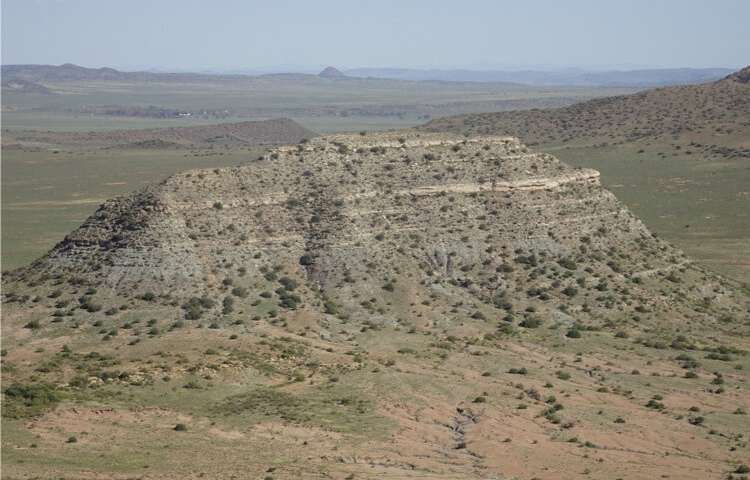The image below is a hill in South Africa with exposed strata from before and after the Permian extinction event (in geological terminology, a Member of the Balfour Formation). The upper part contains layers deposited after the extinction event 252 million years ago. According to new research the mass extinction played out differently and at different times on land and in the sea, as a result of redating a fossil bed in South Africa and another in Australia. Obviously, logic would demand that if there was a global catastrophe this could not be so. Uniformitarianism, on the other hand, dates the sediments laid down in that catastrophe, or any such upheaval, over a long period of time – leading to the situation as claimed at https://doi.org/10.1038/s41467-020-15243-7 … (published in Nature Communications) – see also https://phys.org/news/2020-03-earth-largest-extinction-die-offs-began.html …
 However, the new research is not as simple as that as it involves a redating of the fossils within the sediments. These new dates are said to show that fossilised invertebraes that lived just afte the demise of the fauna that dominated the Late Permian show ecosystem changes that began 300,000 thousand years earlier on land than in the sea. The (later) marine extinction resulted in the disappearance of 95 per cent of life in the sea (it has been calculated) but now it is being suggested it may have occurred over the time span of tens of thousands of years (rather than instantaneously). The argument sounds familiar, much like the clash between different schools of geologists over the K/T boundary event. There we have a crater and an iridium layer that has been found at diverse locations around the world, confirming that an asteroid did indeed embed itself deep within the earth (at Chicxulub) and yet the layers of sediment one might expect from such a catastrophic event (laid down quickly) are instead dated thousands of years either side of the actual boundary itself. It seems like the same thinking is at play at the end of Permian event (although an actual crater is missing from the storyline).
However, the new research is not as simple as that as it involves a redating of the fossils within the sediments. These new dates are said to show that fossilised invertebraes that lived just afte the demise of the fauna that dominated the Late Permian show ecosystem changes that began 300,000 thousand years earlier on land than in the sea. The (later) marine extinction resulted in the disappearance of 95 per cent of life in the sea (it has been calculated) but now it is being suggested it may have occurred over the time span of tens of thousands of years (rather than instantaneously). The argument sounds familiar, much like the clash between different schools of geologists over the K/T boundary event. There we have a crater and an iridium layer that has been found at diverse locations around the world, confirming that an asteroid did indeed embed itself deep within the earth (at Chicxulub) and yet the layers of sediment one might expect from such a catastrophic event (laid down quickly) are instead dated thousands of years either side of the actual boundary itself. It seems like the same thinking is at play at the end of Permian event (although an actual crater is missing from the storyline).
We are told most people thought the terrestrial collapse (the creation of the sediments) began at the same time as the marine collapse (marine debris dumped on the land) – and at the same time all over the world. One line of evidence is said to be that in upper layers of the sediments there is a lack of pollen derived from seed ferns (which dominated the landscape in the Late Permian). Did ferns dominate the landscape all over the earth? That might be so but it may depend on the latitude (which may equally have differed from the latitude of South Africa in the modern world). Perhaps the pollen sank into the bottom layers of the sediment. Another piece of evidence revolves around microscopic silicate crystals (zircons) that form in magma inside volcanoes and are blown into the atmosphere when they erupt – falling back down later in the rain. . These are said to be reliably dated 300,000 years older than the P/T boundary event in China. This means, we are asssured, that the sediments laid down in South Africa are most certainly older than those in China – and the extinction event took place at different times in the southern hemisphere than it did in the northern hemisphere. Even worse, sediment beds in Australia are dated 400,000 years older. The Kroo Basin is famous for its end Permian vertebrae turnover – but again the zircon dates show this predates the mass extinction boundary event. One would have thought the dating of the zircons requires a re-look but this would not have been a highly publicised study if they had said that.
